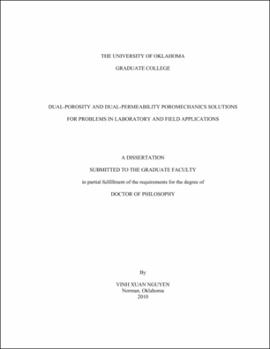| dc.contributor.advisor | Abousleiman, Younane N | |
| dc.creator | Nguyen, Vinh Xuan | |
| dc.date.accessioned | 2019-04-27T21:20:53Z | |
| dc.date.available | 2019-04-27T21:20:53Z | |
| dc.date.issued | 2010 | |
| dc.identifier | 99116800802042 | |
| dc.identifier.uri | https://hdl.handle.net/11244/318465 | |
| dc.description.abstract | In this work, a study of anisotropic dual-porosity and dual-permeability poromechanics is presented through generalized analytical solutions for selected problems in laboratory and field applications. For example, the solution to the inclined wellbore geometry with standard applications in the oil and gas industry for drilling stability or consolidation in naturally fractured rock formations are derived and illustrated. In addition, the dual-porosity and dual-permeability poromechanics solutions to common laboratory testing setups in geomechanics and biomechanics for purposes of rock and bio-tissue characterization are developed for rectangular strip, solid and hollow cylinder geometries. | |
| dc.description.abstract | The behaviors of naturally fractured rock formations or the responses of the well known dual-porosity bone structure are modeled as dual-porosity and dual-permeability poroelastic media that fully couples the secondary porosity medium's deformation, fluid flow and interporosity exchange processes. For chemically active fractured media, e.g., clay, shale, or biomaterial, chemical interaction effects including osmotic and solute transport in both the primary porosity (matrix) and secondary porosity (fracture) are addressed based on non-equilibrium thermodynamics. Thermohydromechanical coupling under non-isothermal condition is incorporated by adopting a "single-temperature" approach in which a single representative thermodynamic continuum is argued to be sufficient to describe the thermally induced responses of a naturally fractured rock formation. | |
| dc.description.abstract | The physical and mathematical models are used to find poromechanics analytical solutions for pore pressure, fluid flux, stress, and displacement, in addition to solute flux for chemically active material or temperature for non-isothermal condition to the above problem geometries. These solutions are general and can be tailored to simulate specific field problems or experimental testing. For instance, the inclined wellbore solutions include boundary conditions for simulating openhole drilling and fluid injection or withdrawal. On the other hand, the solutions for laboratory testing of rectangular and cylinder geometries account for two primary axial loading modes, namely, stroke control or stress relaxation and load control or creep test. The rectangular strip solution is also shown to simplify to the classical one-dimensional consolidation in soil mechanics. | |
| dc.description.abstract | For non-reactive dual-porous material under isothermal condition, generic dual-poromechanics results are plotted and compared with single-poromechanics counterpart representing a homogenous isotropic medium when applicable. Parametric analyses are also carried out through the responses of a solid cylinder under unconfined compression to evaluate the effects of material anisotropy and dimensionless dual-poroelastic parameters such as permeability ratio, storage ratio, and interporosity coefficient. For chemically active fractured formation, the analyses is focused on the impacts of chemical salinity gradients via osmotic and solute transport on pore pressure and effective stress distributions near the wellbore or fluid/solute flux and displacement of solid cylinder under axial-flow-only oedometer testing setup. Finally, the effects of temperature gradients manifested through thermal expansion/contraction and conductive heat transport are assessed using the analytical solutions for inclined wellbore and rectangular strip geometries. Furthermore, the significance of heat convection is evaluated numerically and displayed. | |
| dc.description.abstract | Application-wise, the inclined wellbore solution is used to perform time-dependent wellbore stability analysis for drilling through chemically active fractured rock formations under non-isothermal conditions. The hollow cylinder is applied to study elastic consolidation of a producing naturally fractured reservoir and associated implications on porosity and permeability reduction in the near-wellbore region. Finally, some realistic quasi-static loading conditions commonly encountered in experimental testing and field applications such as cyclic, linear ramping, and exponentially decayed are demonstrated via the solutions of unconfined solid cylinder. | |
| dc.format.extent | 297 pages | |
| dc.format.medium | application.pdf | |
| dc.language | en_US | |
| dc.relation.requires | Adobe Acrobat Reader | |
| dc.subject | Porous materials--Mechanical properties | |
| dc.subject | Porosity | |
| dc.subject | Permeability | |
| dc.subject | Fracture mechanics | |
| dc.subject | Boring | |
| dc.title | Dual-Porosity and Dual-Permeability Poromechanics Solutions for Problems in Laboratory and Field Applications | |
| dc.type | text | |
| dc.type | document | |
| dc.thesis.degree | Ph.D. | |
| ou.group | Mewbourne College of Earth and Energy::Mewbourne School of Petroleum and Geological Engineering | |
